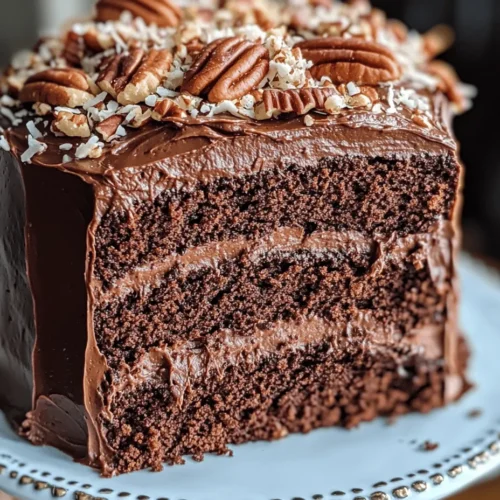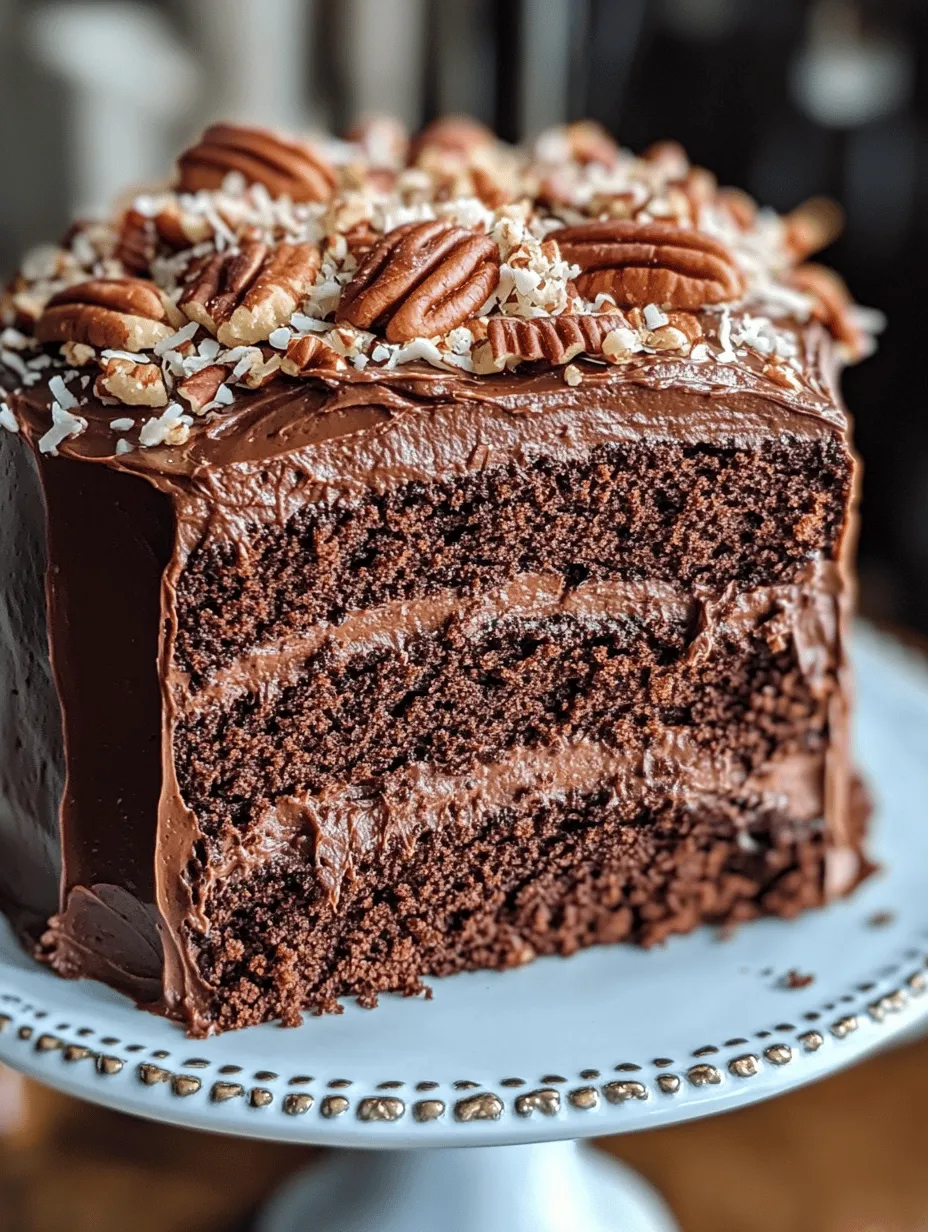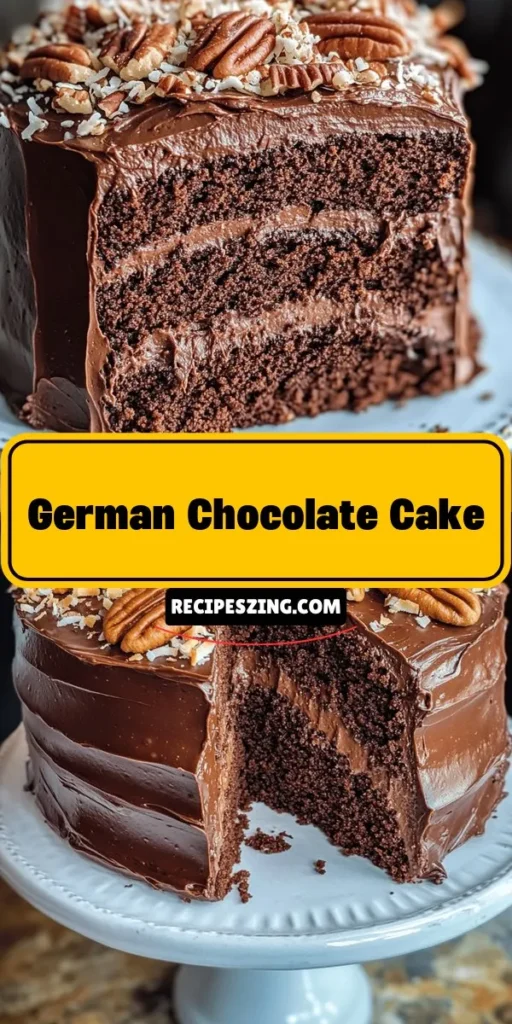Introduction
If there’s a dessert that embodies indulgence and nostalgia, it’s the German Chocolate Cake. This rich, layered cake is not just a treat for the taste buds but also a journey through its fascinating history and unique flavor profile. Originating in the United States—despite its name—German Chocolate Cake is a delightful confection that features a luscious chocolate cake, typically filled and topped with a decadent coconut-pecan frosting. The cake balances sweet and nutty flavors, creating a unique blend that leaves a lasting impression.
The flavor profile of German Chocolate Cake is nothing short of heavenly. The chocolate layers are moist and rich, complemented perfectly by a sweet, chewy coconut-pecan frosting that brings a delightful crunch. Each slice offers a harmonious blend of chocolate, coconut, and nuts, making it a beloved choice for celebrations and gatherings. The cake’s texture is equally important; it’s a tender, melt-in-your-mouth experience, enhanced by the creaminess of the frosting.
In an age where store-bought desserts are prevalent, nothing compares to the joy of creating homemade sweets. Baking a German Chocolate Cake from scratch not only allows you to control the quality of your ingredients but also brings a sense of accomplishment and warmth to any occasion. Whether you’re celebrating a birthday, an anniversary, or simply indulging in a midweek treat, this cake promises to create memorable experiences that you and your loved ones will cherish.
Understanding German Chocolate Cake
Historical Background and Cultural Significance
The history of German Chocolate Cake is as rich as its flavor. Contrary to popular belief, the cake is not German in origin. It is named after an American named Samuel German, who created a dark-baking chocolate for the Baker’s Chocolate Company in 1852. The cake itself became popular in the United States in the 1950s when a recipe for “German’s Chocolate Cake” was published in a Dallas, Texas newspaper. The recipe quickly gained traction, and the name gradually morphed into “German Chocolate Cake.”
This cake holds cultural significance in American baking traditions, often appearing at family gatherings, holiday celebrations, and special occasions. Its layered structure and unique frosting make it a showstopper, perfect for impressing guests and bringing a sense of joy to any dessert table.
Key Ingredients That Define the Cake
At the heart of German Chocolate Cake are its key ingredients, which contribute to its distinctive flavor and texture. Understanding these components is essential for recreating this beloved dessert successfully.
1. All-Purpose Flour: This is the backbone of the cake, providing the necessary structure. The flour’s gluten content helps the cake rise and maintain its shape while still being tender.
2. Cocoa Powder: Unsweetened cocoa powder is crucial for giving the cake its deep chocolate flavor. It adds richness and complexity, balancing well with the sweetness of the frosting.
3. Buttermilk: This ingredient is essential for achieving the cake’s moist texture. The acidity in buttermilk reacts with baking soda, helping the cake rise while also contributing to its tender crumb. It also adds a subtle tang that enhances the overall flavor.
4. Coconut and Pecans: These ingredients are not just for the frosting; they play a significant role in defining the cake’s character. The shredded coconut adds chewiness and sweetness, while the pecans provide a delightful crunch and nutty flavor.
Distinction Between German Chocolate and German Chocolate Cake
It’s important to clarify the distinction between “German chocolate” and “German Chocolate Cake.” The former refers to the specific type of dark-baking chocolate developed by Samuel German. In contrast, the latter is the cake itself, which combines layers of chocolate cake with a unique coconut-pecan frosting. This misunderstanding often leads to confusion, but knowing the difference enriches your appreciation for this delightful dessert.
Ingredients Breakdown
Overview of the Essential Components for the Cake
To create an unforgettable German Chocolate Cake, you’ll need to gather the following essential ingredients:
– All-purpose flour: 2 cups
– Cocoa powder: 3/4 cup
– Granulated sugar: 2 cups
– Baking soda: 1 teaspoon
– Baking powder: 1 teaspoon
– Salt: 1 teaspoon
– Buttermilk: 1 cup
– Vegetable oil: 1/2 cup
– Eggs: 4 large
– Vanilla extract: 2 teaspoons
– Boiling water: 1 cup
The Importance of Buttermilk in Achieving Moisture and Flavor
Buttermilk is a key player in achieving the moist, tender crumb that characterizes an exceptional German Chocolate Cake. Its acidity breaks down the gluten in the flour, resulting in a softer texture. Additionally, buttermilk contributes a subtle tanginess that balances the sweetness of the cake, ensuring that every bite is deliciously complex. If you don’t have buttermilk on hand, you can create a substitute by mixing one cup of milk with one tablespoon of white vinegar or lemon juice, letting it sit for about five minutes before using.
Detailed Description of the Coconut-Pecan Frosting
The finishing touch that elevates a German Chocolate Cake is its signature Coconut-Pecan Frosting. This frosting is made from a blend of sweetened shredded coconut, chopped pecans, evaporated milk, sugar, butter, and egg yolks. The combination of these ingredients creates a rich, creamy topping that is both sweet and nutty. The coconut adds a tropical flair, while the pecans provide a satisfying crunch.
To make the frosting, you’ll need:
– Sweetened shredded coconut: 2 cups
– Pecans: 1 cup, chopped
– Evaporated milk: 1 cup
– Granulated sugar: 1 cup
– Butter: 1/2 cup
– Egg yolks: 3 large
– Vanilla extract: 1 teaspoon
Role of Coconut and Pecans in Flavor and Texture
The coconut and pecans in the frosting not only provide texture but also enhance the overall flavor profile of the cake. The shredded coconut offers a chewy, fibrous element that contrasts beautifully with the smooth chocolate layers, while the pecans add a nutty richness that complements the sweet frosting. This combination is what makes the frosting uniquely delicious and an essential part of the German Chocolate Cake experience.
Exploration of the Chocolate Frosting
While the Coconut-Pecan Frosting is the star of the show, a rich chocolate frosting can serve as an excellent base layer between the cake’s tiers. The chocolate frosting typically consists of:
– Butter: 1 cup, softened
– Cocoa powder: 2/3 cup
– Powdered sugar: 3 cups
– Heavy cream or milk: 1/3 cup
– Vanilla extract: 1 teaspoon
This chocolate frosting is smooth and creamy, with a deep cocoa flavor that pairs perfectly with the cake. The butter and cocoa powder together create a rich consistency that can be spread between layers and on the top of the cake, providing a luscious backdrop to the coconut-pecan frosting.
Step-by-Step Instructions for the Cake
Preparing the Cake Pans and Preheating the Oven
Before diving into mixing the ingredients, it’s essential to prepare your baking environment. Preheat your oven to 350°F (175°C). While the oven is heating, you can prepare your cake pans. Grease and flour two 9-inch round cake pans, ensuring that the bottoms and sides are coated to prevent sticking. You can also line the bottoms with parchment paper for extra protection.
Mixing Dry Ingredients and the Science Behind Baking Soda and Powder
Once your pans are ready, it’s time to focus on the dry ingredients. In a large mixing bowl, combine the all-purpose flour, cocoa powder, granulated sugar, baking soda, baking powder, and salt. Whisk the ingredients together until well combined. The baking soda and baking powder play crucial roles in the cake’s rise; baking soda requires an acid (like buttermilk) to activate, while baking powder has both an acid and a base, ensuring a good lift during baking.
The Process of Combining Wet Ingredients and Achieving the Right Batter Consistency
In a separate bowl, mix the wet ingredients: buttermilk, vegetable oil, eggs, and vanilla extract. Whisk them together until fully combined. Gradually add the wet ingredients to the dry mixture, stirring gently. As you mix, pour in the boiling water to the batter. This step is crucial as it helps dissolve the cocoa powder and creates a thinner batter that results in a moist and tender cake.
Baking and Cooling: Importance of Patience During Cooling
Once the batter is well combined, pour it evenly into the prepared cake pans. Bake in the preheated oven for about 30 to 35 minutes, or until a toothpick inserted in the center comes out clean. Baking times may vary based on your oven, so keep an eye on your cakes as they bake.
After removing the cakes from the oven, allow them to cool in the pans for about 10 minutes before transferring them to a wire rack to cool completely. Patience is key at this stage; allowing the cakes to cool completely will ensure that the layers hold their shape when frosting them later.
—
In the next part of this recipe article, we will cover the creation of the Coconut-Pecan Frosting, the assembly of the cake, and some expert tips for making this dessert truly extraordinary. Stay tuned as we continue our journey into the delightful world of German Chocolate Cake!

Crafting the Coconut-Pecan Frosting
To create the perfect Coconut-Pecan Frosting for your Heavenly German Chocolate Cake, start by gathering the following ingredients:
– 1 cup granulated sugar
– 1 cup evaporated milk
– 1/2 cup unsalted butter
– 1 1/2 cups sweetened shredded coconut
– 1 cup chopped pecans
– 1 teaspoon vanilla extract
– A pinch of salt
Cooking Instructions for the Frosting
1. Combine the Base Ingredients: In a medium saucepan over medium heat, mix together the granulated sugar, evaporated milk, and unsalted butter. Stir constantly until the butter melts completely and the mixture begins to boil.
2. Thickening Process: Once the mixture reaches a boil, reduce the heat to low and continue to cook for about 10-12 minutes. Stir frequently to prevent the mixture from sticking to the pan. The goal is to achieve a thick, syrupy consistency. This step is crucial as it allows the sugar to dissolve fully and the frosting to set properly later.
3. Incorporate Coconut and Pecans: After the mixture has thickened, remove it from the heat. Stir in the shredded coconut, chopped pecans, vanilla extract, and a pinch of salt. Mix well until all ingredients are evenly distributed.
4. Cooling Tips: Transfer the frosting to a bowl and let it cool at room temperature. The cooling process allows the frosting to thicken further, making it easier to spread over the cake layers. Avoid refrigerating it, as this can make it too firm to spread evenly.
Making the Chocolate Frosting
Once your Coconut-Pecan Frosting is ready, it’s time to prepare the rich Chocolate Frosting. You will need:
– 1 cup unsalted butter, softened
– 3 1/2 cups powdered sugar
– 1/2 cup unsweetened cocoa powder
– 1/4 cup heavy cream
– 1 teaspoon vanilla extract
– A pinch of salt
Step-by-Step Guide to Achieving the Perfect Consistency
1. Beat the Butter: In a large mixing bowl, beat the softened butter with an electric mixer on medium speed until light and fluffy, about 2-3 minutes. This step is essential as it incorporates air into the butter, creating a smooth and creamy base for the frosting.
2. Gradual Mixing: Gradually add in the powdered sugar and cocoa powder, alternating with the heavy cream. Mix on low speed to prevent a sugary explosion, then increase to medium speed until the ingredients are fully incorporated. Scrape down the sides of the bowl as needed.
3. Finishing Touches: Add the vanilla extract and a pinch of salt, then continue beating for another 1-2 minutes until the frosting is smooth and spreadable. If the frosting is too thick, add a little more heavy cream, one tablespoon at a time, until you reach your desired consistency.
Assembling the Cake
With both frostings prepared, it’s time to assemble your cake.
Techniques for Layering and Frosting the Cake
1. Layer the Cakes: Place one of the chocolate cake layers on a serving plate. Use a serrated knife to trim the top if it domed during baking, creating a flat surface. This helps in stacking the layers evenly.
2. Apply the Frostings: Spread a generous layer of the Coconut-Pecan Frosting over the first layer. Top with the second layer of cake and repeat the process. If you are using a third layer, simply continue layering and adding frosting.
3. Frost the Sides and Top: Once the layers are stacked, use the Chocolate Frosting to cover the top and sides of the cake. Use an offset spatula for a smooth finish. For a rustic look, you can create swirls or peaks in the frosting.
Tips for Achieving a Clean Finish
– Chill the Cake: After frosting, place the assembled cake in the refrigerator for about 30 minutes. This helps set the frosting and makes cutting the cake easier.
– Use a Warm Spatula: To achieve a clean finish, dip your spatula in warm water and wipe it dry before smoothing the frosting. The warmth helps the frosting glide more easily.
Creative Decoration Ideas
For a visually appealing presentation, sprinkle additional toasted coconut and chopped pecans on top of the cake. You can also use chocolate shavings or curls to add an extra touch of elegance. Consider placing a few whole pecans around the base for a decorative border.
Serving Suggestions and Pairings
Heavenly German Chocolate Cake is perfect for various occasions, from birthday celebrations to holiday gatherings.
Ideal Occasions for Serving
– Birthdays: A classic dessert for any birthday party.
– Celebrations: Perfect for anniversaries, graduations, or family reunions.
– Holidays: A festive treat during Thanksgiving or Christmas dinners.
Beverage Pairings
To complement the rich flavors of the cake, consider serving it with:
– Coffee: A cup of freshly brewed coffee enhances the chocolate richness.
– Milk: A classic pairing that balances the sweetness of the cake.
– Dessert Wine: A sweet dessert wine can offer a delightful contrast to the cake’s flavors.
Presentation Tips
For an impressive display, serve slices on elegant dessert plates. Garnish with a sprig of mint or a scoop of vanilla ice cream on the side for a sophisticated touch.
Nutritional Information
While enjoying your Heavenly German Chocolate Cake, it’s good to be aware of its nutritional content. Each slice (1/12 of the cake) contains approximately:
– Calories: 450
– Total Fat: 25g
– Saturated Fat: 15g
– Carbohydrates: 55g
– Sugars: 35g
– Protein: 5g
Discussion on Moderation
Rich desserts like this cake are best enjoyed in moderation. While it’s tempting to indulge, consider sharing the cake with friends and family to spread joy (and calories) around. Remember, the experience of baking and sharing is just as important as the dessert itself.
Conclusion
Making and sharing a homemade Heavenly German Chocolate Cake is a rewarding experience that brings joy to both the baker and those who enjoy it. This cake not only satisfies sweet cravings but also serves as a centerpiece for many cherished family traditions and celebrations.
As you explore this recipe, don’t hesitate to experiment with variations—such as adding a layer of raspberry jam for a tart contrast or infusing the chocolate frosting with espresso for a deeper flavor. Each twist can create a unique signature cake that reflects your personal touch.
Celebrate the joy of baking, the love of sharing, and the memories created around the table with this timeless dessert. Heavenly German Chocolate Cake is more than just a treat; it’s a slice of happiness, perfect for any occasion.



